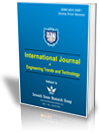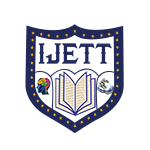Analysis of Electronic Waste Management and its Influence on Environmental Sustainability: Municipalities of the Northern Region of Peru
Analysis of Electronic Waste Management and its Influence on Environmental Sustainability: Municipalities of the Northern Region of Peru |
||
 |
 |
|
| © 2025 by IJETT Journal | ||
| Volume-73 Issue-3 |
||
| Year of Publication : 2025 | ||
| Author : Percy Junior Castro Mejia, Joser Emanuel Granda Novoa, Arly Briggitte Izquierdo Yrigoin, Hernaldo Manuel Jiménez Flores, Lenard Medina Diaz, Javier Vilchez Romero, Jean Carlos Castañeda Ramírez |
||
| DOI : 10.14445/22315381/IJETT-V73I3P111 | ||
How to Cite?
Percy Junior Castro Mejia, Joser Emanuel Granda Novoa, Arly Briggitte Izquierdo Yrigoin, Hernaldo Manuel Jiménez Flores, Lenard Medina Diaz, Javier Vilchez Romero, Jean Carlos Castañeda Ramírez, "Analysis of Electronic Waste Management and its Influence on Environmental Sustainability: Municipalities of the Northern Region of Peru," International Journal of Engineering Trends and Technology, vol. 73, no. 3, pp. 140-159, 2025. Crossref, https://doi.org/10.14445/22315381/IJETT-V73I3P111
Abstract
The study objective of this work was to evaluate whether there is a relationship between the analysis of electronic waste management and its influence on environmental sustainability in the municipalities of the northern region of Peru 2022-2024. Methodologically, the study uses a quantitative approach with a non-experimental cross-sectional design and a descriptive scope. The sample was made up of 95 inhabitants, selected through non-probabilistic convenience sampling, representing a population of 85,467 inhabitants of the mentioned region. A questionnaire of 30 closed questions on an ordinal/Likert scale was used to collect data. This instrument was validated using Aiken's alpha coefficient, ensuring the items were relevant and appropriate for the study context. In addition, the Delphi method was applied to involve experts in electronic waste management, which allowed for obtaining a consensus on the best practices and strategies to implement. The main results indicate that electronic waste management moderately influences environmental sustainability. This is evidenced through the Spearman coefficients: 0.363 for the dependent and independent variables, 0.358 for storage, 0.376 for disposition and transformation with a p-value of 0.000, and 0.327 for handling and collection with a p-value of 0.001 in all cases. The main conclusion is that electronic waste management contributes to environmental sustainability, highlighting the importance of managing this waste for the sustainable development of our environmental environment.
Keywords
Electronic waste management, Environmental sustainability, Municipalities of northern Perú, Impact analysis, Sustainable development.
References
[1] Waste from Electrical and Electronic Equipment (WEEE), European Commission, 2023. [Online]. Available: https://environment.ec.europa.eu/topics/waste-and-recycling/waste-electrical-and-electronic-equipment-weee_en
[2] Jiachao Ke et al., “Promoting Solid Waste Management and Disposal Through Contingent Valuation Method: A Review,” Journal of Cleaner Production, vol. 379, 2022.
[CrossRef] [Google Scholar] [Publisher Link]
[3] Daniel Salmon et al., “A Framework for Modeling Fraud in E-Waste Management,” Resources, Conservation, and Recycling, vol. 171, 2021.
[CrossRef] [Google Scholar] [Publisher Link]
[4] Md Tasbirul Islam et al., “A Global Review of Consumer Behavior Towards E-Waste and Implications for The Circular Economy,” Journal of Cleaner Production, vol. 316, 2021.
[CrossRef] [Google Scholar] [Publisher Link]
[5] Zahra Ansari Cheshmeh et al., “A Comprehensive Review of Used Electrical and Electronic Equipment Management with a Focus on Circular Economy-Based Policymaking,” Journal of Cleaner Production, vol. 389, 2023.
[CrossRef] [Google Scholar] [Publisher Link]
[6] Michael Wellington Apprey et al., “Sustainable Practices in E-Waste Management: A Study of Electronic Repair Technicians in Ho Municipality, Ghana,” Journal of Applied Research on Industrial Engineering, vol. 11, no. 1, pp. 1-23, 2024.
[CrossRef] [Google Scholar] [Publisher Link]
[7] M. Amin Mir, and Sook Keng Chang, “Saudi Arabia E-Waste Management Strategies, Challenges and Opportunities, Effect on Health and Environment: A Strategic Review,” Emerging Contakets, vol. 10, no. 4, pp. 1-13, 2024.
[CrossRef] [Google Scholar] [Publisher Link]
[8] Yifeng He et al., “Environmental Footprint Analysis of Gold Recycling from Electronic Waste: A Comparative Life Cycle Analysis,” Journal of Cleaner Production, vol. 432, 2023.
[CrossRef] [Google Scholar] [Publisher Link]
[9] Dextre Minaya, and Rosa Maria Alejandra, “Life Cycle Analysis (LCA) of the Management of Waste Electrical and Electronic Equipment (WEEE) by the Waste Operating Company Comimtel SAC, Lima, Period 2017-2019,” Master Thesis, Santiago Antúnez de Mayolo National University, Huaraz, Peru, 2020.
[Google Scholar] [Publisher Link]
[10] Carpio Del Carpio et al., “Management of Waste Electrical and Electronic Devices for an Improvement Proposal in the Municipality of Arequipa,” Master Thesis, César Vallejo University, Lima, Perú 2021.
[Google Scholar] [Publisher Link]
[11] Jose Luis Sifuentes Alor, “Electronic Components and their Recycling Methods for Students of the Sixth Cycle of Electronic Engineering at the José Faustino Sánchez Carrión National University,” Master Thesis, José Faustino Sánchez Carrión National University, La Libertad, Perú, pp. 1-68, 2023.
[Google Scholar] [Publisher Link]
[12] Roxana Maribel Gastelo Tello, “Waste Management System for Electrical and Electronic Devices from Homes in the District of Chiclayo,” Master Thesis, Pedro Ruiz Gallo National University, Lambayeque, Perú 2019.
[Google Scholar]
[13] Rosa Alexandra Orrillo Guerrero, and Melissa Chriss Pérez Lozada, “The Habits of Use and Reuse of Electronic Goods by the Public Institutions of the District of Lambayeque and their Contribution to the Administration of these in their Residual State: A Study from Communication,” Master Thesis, Pedro Ruiz Gallo National University, Lambayeque, Perú, pp. 1-110, 2019.
[Google Scholar] [Publisher Link]
[14] I. Orrego Campos, and J.G. Vasquez Montaño, “Business Plan for the Creation of an Electrical and Electronic Equipment Recycling Plant in Lambayeque, 2021,” Master Thesis, César Vallejo University, Lambayeque, Perú 2021.
[Google Scholar]
[15] Luis Alfonso Mendoza Gonzales, “A Management Model for the Recycling of Electrical and Electronic Waste to Reduce Environmental Pollution in the City of Chiclayo,” Master Thesis, Pedro Ruiz Gallo National University, Lambayeque, Perú, pp. 1-133, 2023.
[Google Scholar] [Publisher Link]
[16] Herman E. Daly, Sustainable Development and Optimal Scale of the Economy, Ecology and Development. Madrid: UCM, pp. 73-86, 1996.
[Google Scholar]
[17] Michael Braungart, William McDonough, and Andrew Bollinger, “Cradle-To-Cradle Design: Creating Healthy Emissions-A Strategy for Eco-Effective Product and System Design,” Journal of Cleaner Production, vol. 15, no. 13-14, pp. 1337-1348, 2007.
[CrossRef] [Google Scholar] [Publisher Link]
[18] E. Macarthur, and H. Heading, “How the Circular Economy Addresses Climate Change,” Journal of Ellen MacArthur Found, vol. 1, pp. 1-71, 2019.
[Google Scholar] [Publisher Link]
[19] Thomas Lys, and Jowell S. Sabino, “Research Design Issues in Grouping-Based Tests,” Journal of Financial Economics, vol. 32, no. 3, pp. 355-387, 1992.
[CrossRef] [Google Scholar] [Publisher Link]
[20] E. Nicaragua, “Research Methodology and Applied Research for Economic and Administrative Sciences,” Journal of the Autonomous University, vol. 1, no. 1, pp. 1-89, 2018.
[Google Scholar]
[21] W.T. Hurtado Manzano, and J.L. Moreno Balsa, “Management of Electrical and Electronic Waste, and its Relationship in the Social and Environmental Environment at Critical Points in Jirón Prolongation Leticia-Lima, 2023,” César Vallejo University, Lima, Peru, 2023.
[Publisher Link]
[22] Marco Gusukuma, Ramzy Kahhat, and Kathia Cáceres, “Evolution of the Stock of Electrical and Electronic Equipment in the Peruvian Residential Sector,” Journal of Industrial Ecology, vol. 26, no. 3, pp. 952-963, 2022.
[CrossRef] [Google Scholar] [Publisher Link]
[23] José Ignacio de Granda-Orive, and Cristina Garcia-Quero, “E-Waste: Rare Earth Elements, New Toxic Substances in Cigarettes and Electronic Cigarettes,” Bronchopulmonology Archives, vol. 5, no. 8, pp. 477-478, 2020.
[CrossRef] [Google Scholar] [Publisher Link]
[24] Zaida Michelle Reyna Mendoza, “Diagnosis of Waste Management of Electrical and Electronic Devices to Improve Environmental Management in the Callería District,” Province of Colonel Portillo-Ucayali 2018,” Scientific University of the South, Lima, Peru, 2019.
[Google Scholar] [Publisher Link]
[25] Blanca Flor Robles Pastor, “Population and Sample,” Journal Continent People, vol. 30, no. 1, pp. 245-247, 2019.
[Google Scholar] [Publisher Link]
[26] Roberto Hernández-Sampieri, R. Fernández-Collado, and Pilar Baptista-Lucio, “Sample Selection,” Research Methodology, vol. 6, no.1, pp. 170-191, 2014.
[Google Scholar] [Publisher Link]
[27] Luis Florencio Mucha Hospital, and Miryam Griselda Lora Loza, Sampling Technique for Quantitative Research: Computer Application, César Vallejo University Lima, Peru, 2021.
[Google Scholar] [Publisher Link]
[28] Dania Ma Orellana Lopez, and Ma Cruz Sánchez Gómez, “Data Collection Techniques in Virtual Environments are Most Used in Qualitative Research,” Journal of Educational Research, vol. 24, no. 1, pp. 205-222, 2006.
[Google Scholar] [Publisher Link]
[29] Ebingen Villavicencio Caparó, “Validation of Questionnaires,” Active Dentistry Scientific Magazine, vol. 1, no. 3, pp. 71-76, 2016.
[Google Scholar] [Publisher Link]

